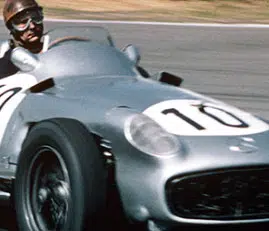2002 F1 World Championship
- 2002
- F1
- F1 World Championship
Ferrari’s Formula 1 stranglehold tightened in a season of increasing dominance and yet more records. Michael Schumacher equalled Juan Manuel Fangio’s long-standing tally of five World Championship victories, and by a wide margin. He finished every lap of the season, every race on the podium, and won eleven times – each establishing a new benchmark. Ferrari scored as many points as the rest of the field combined.
Although the team started the year with its 2001 car, it still dominated the Australian Grand Prix. Ferrari introduced the F2002 after Schumacher could only finish third in Malaysia, his worst result of the year. The car proved so dominant that Schumacher and team-mate Rubens Barrichello would only lose once more. But Ferrari angered F1 fans and the establishment by imposing team orders as early as the Austrian GP in May, when it demanded that Barrichello relinquish the lead. This race had been Barrichello’s finest in F1: he outpaced Schumacher in qualifying and again in the race before pulling over after the last corner. The Brazilian did win four races later in the season, but the suspicion always lingered that his team-mate was paying him back for Austria.
Williams-BMW proved a major disappointment following the promise displayed in 2001. Ralf Schumacher did lead a 1-2 for the team in Malaysia but that was their only win. Juan Pablo Montoya qualified on pole position for seven races including averaging 161.423 mph at Monza to set a new record for a single GP qualifying lap, eclipsing the previous best set by Keke Rosberg at Silverstone in 1985. But despite having the most powerful engine in F1, the combination of the Williams chassis and Michelin tyres did not have the pace to challenge over a race distance. Ferrari enjoyed being the only leading team supplied tyres by Bridgestone, while Williams shared Michelin with McLaren-Mercedes.
David Coulthard held off Michael Schumacher at Monaco to score McLaren’s only win of the year but he could only finish fifth in the championship. Kimi Raikkonen replaced countryman Mika Hakkinen as Coulthard’s team-mate and emerged as a true star of the future. He would have won at Magny-Cours had he not run wide in a corner after slipping on oil late in the race. That allowed Schumacher by, and Raikkonen had to settle for second place. Spectacular wheel-to-wheel dices with Montoya at Hockenheim and Hungaroring further demonstrated that Raikkonen had championship potential.
Apart from these three teams only Eddie Irvine’s improving Jaguar recorded a podium finish when third at Monza. Jenson Button re-established himself with a series of points finishes and, together with Jarno Trulli, helped Renault to fourth place in the championship. Local drivers earned their place in the media spotlight in the first and last races of the season. Minardi’s Mark Webber and Jordan’s Takuma Sato were ecstatic to finish fifth in Australia and Japan respectively.
Toyota made their long-awaited F1 debut and competition with the Honda-powered BAR and Jordan teams to be top Japanese manufacturer became one of the year’s sub-plots. Mika Salo finished sixth in two early races for Toyota but both BAR and Jordan passed their rivals as the year progressed.
The effects of an uncertain world economy were felt in F1 with several teams struggling to find sufficient sponsorship. Prost went out of business before the season began and Arrows disappeared with five races remaining.





